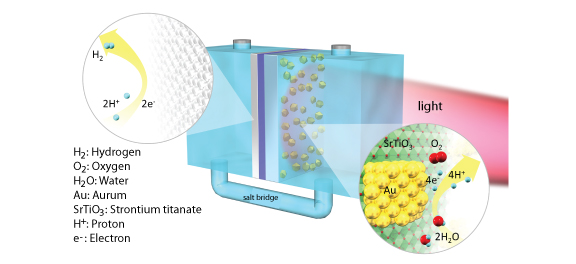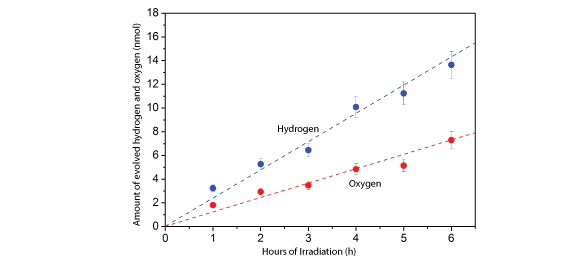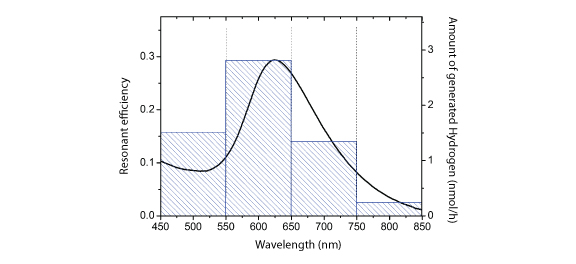Successful Development of an Artificial Photosynthesis System Which Uses Visible Light and Separates Evolved Hydrogen and Oxygen
Research Press Release | July 17, 2014
-
 Fig. 1 A Plasmon-assisted water splitting diagram.
Fig. 1 A Plasmon-assisted water splitting diagram. -
 Fig. 2 The correlation between the amount of hydrogen and oxygen generated and the hours of irradiation when light at a wavelength of 550-650 nm is irradiated on gold nanoparticles.
Fig. 2 The correlation between the amount of hydrogen and oxygen generated and the hours of irradiation when light at a wavelength of 550-650 nm is irradiated on gold nanoparticles. -
 Fig. 3 Plasmon resonance spectrum (straight line) and the action spectrum of the amount of evolved hydrogen (bar chart).
Fig. 3 Plasmon resonance spectrum (straight line) and the action spectrum of the amount of evolved hydrogen (bar chart).
| Press Release | ||
|---|---|---|
| Key Points |
・Hydrogen and oxygen was evolved by splitting water which was performed by exciting the localized plasmon resonance with a 450-850 nm visible and near-infrared light. ・Hydrogen and oxygen was successfully separated and evolved from a reaction chamber installed on the front and back of the SrTiO3 substrate. |
|
| Overview |
Research in artificial photosynthesis which can stably store renewable solar energy and convert it into chemical energy (chemical substance) which can be easily transferred, is expected to be a key technology to solve environment/energy issues currently facing humankind. The research group headed by Professor Hiroaki Misawa and associate professor Kosei Ueno of the Research Institute for Electronic Science, Hokkaido University, in collaboration with Haruo Inoue specially appointed professor of Tokyo Metropolitan University, and Professor Kei Murakoshi of the Graduate School of Science, Hokkaido University, have successfully developed artificial photosynthesis using 650-850 nm visible far-red light, which could not be used in conventional artificial photosynthesis until now, and an oxide semiconductor substrate that can support metal nanoparticles which functions as a light antenna. Furthermore, using an extremely simple system by setting a different metal on the front and back of the substrate, the researchers successfully performed water splitting, and separated hydrogen and oxygen from each side. The research group demonstrated the possibility of separating hydrogen using a method which differs from conventional thinking. |
|
| Inquiries |
Hiroaki Misawa, Professor, Research Institute for Electronic Science, Hokkaido University TEL: +81-11-706-9358 FAX: +81-11-706-9359 E-mail:misawa@es.hokudai.ac.jp |
|
|
Japanese Link |
全可視光の利用と発生した水素・酸素の分離を同時に可能にする人工光合成システムの開発に成功 | |
| Publications | Angewandte Chemie International Edition (Die Gesellschaft Deutscher Chemiker) (web edition 2014.7.2 ) | |
